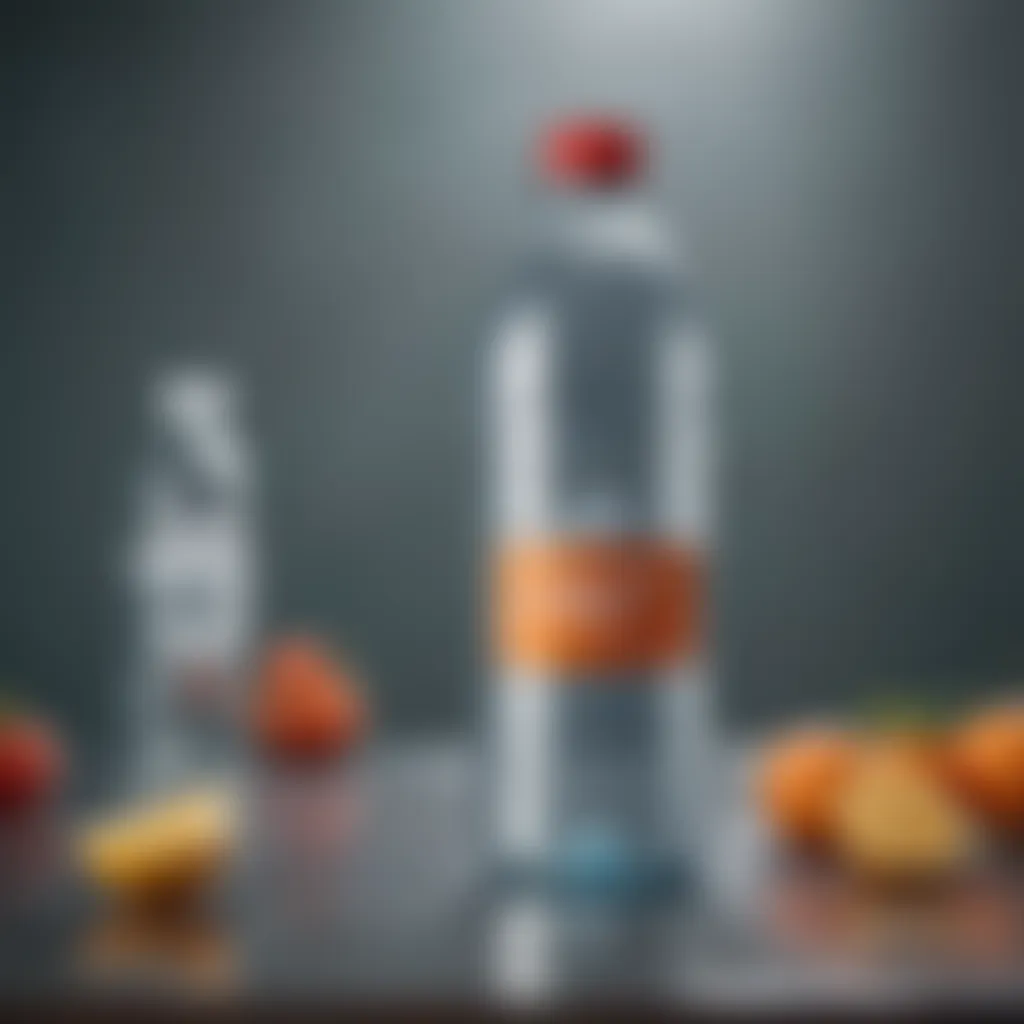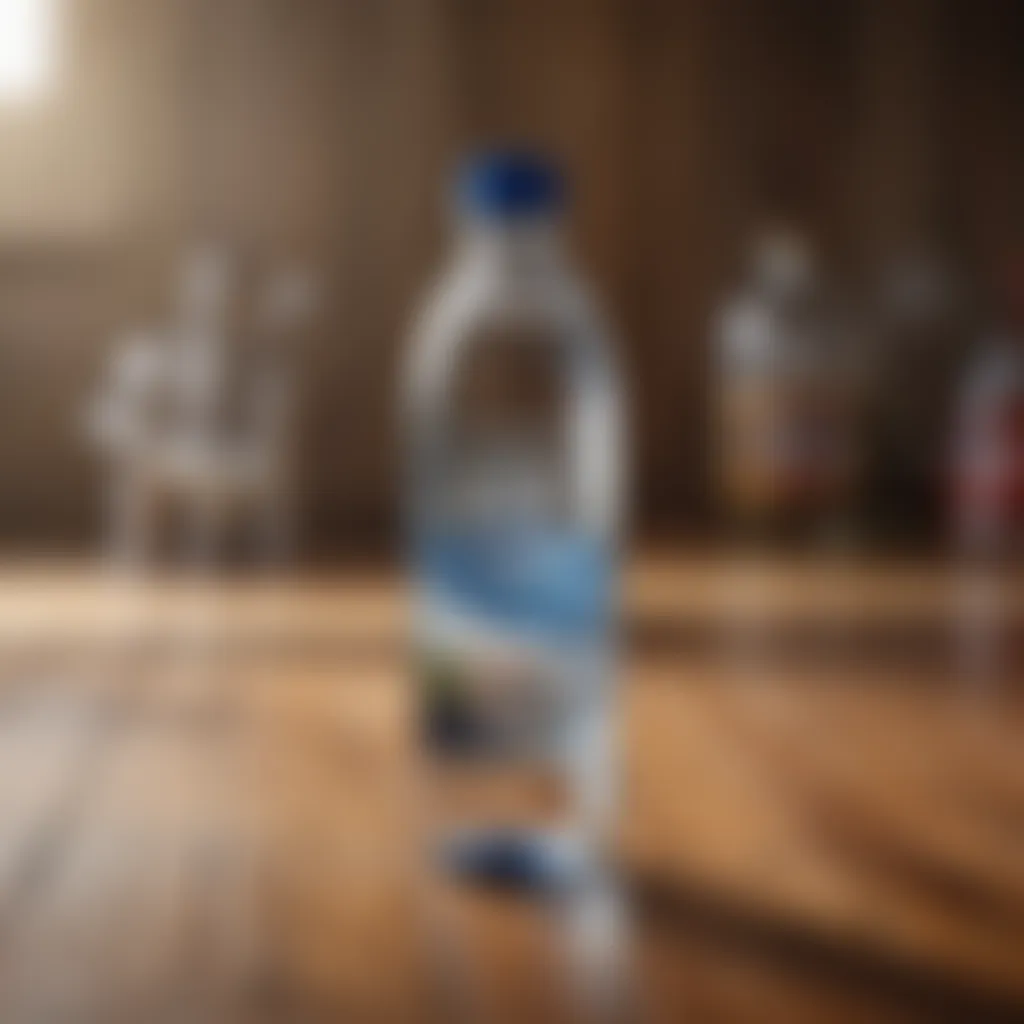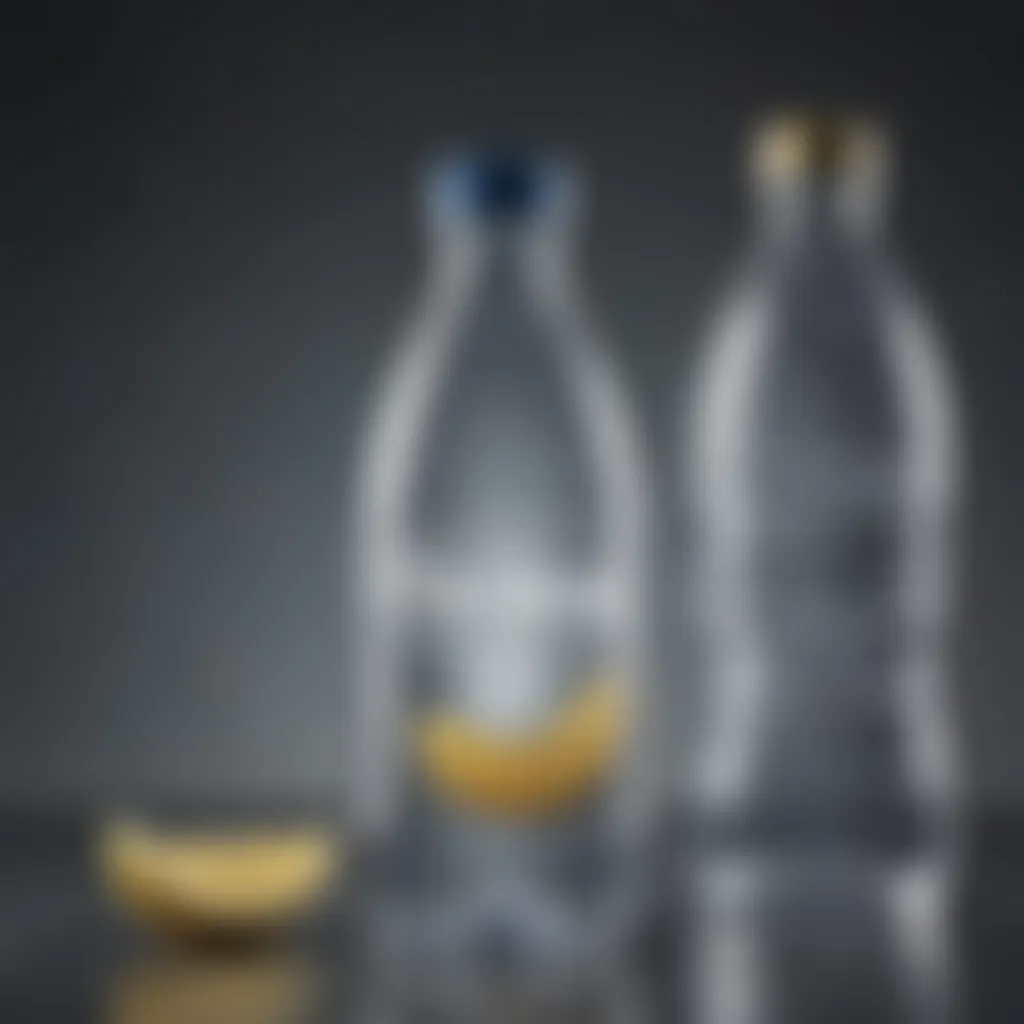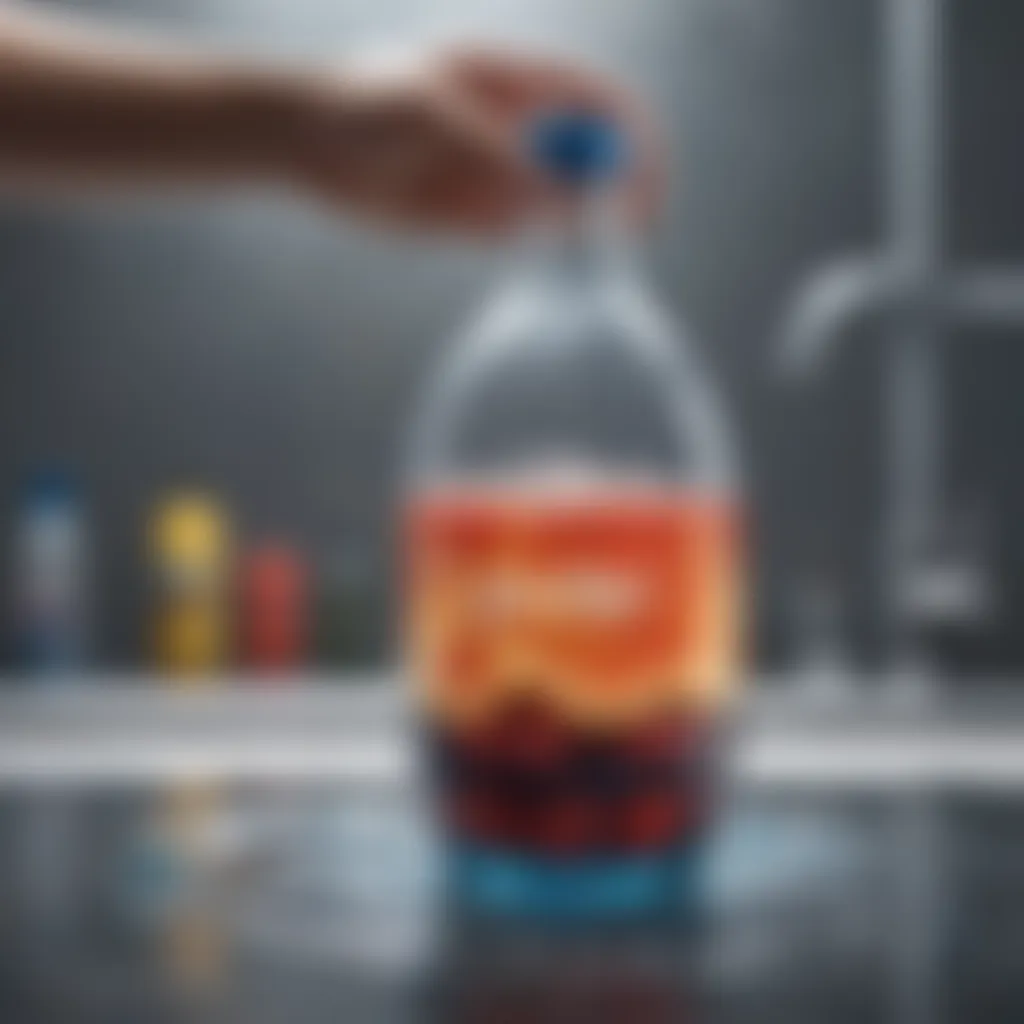The Importance and Efficacy of Water Cleaning Bottles


Intro
Ingredients:
While the main ingredient in this narrative is water, there are additional factors that contribute to maintaining clean water bottles.
- Water: Clean and filtered water for refilling.
- Vinegar: An effective natural cleaning agent. Use white or apple cider vinegar.
- Baking Soda: A gentle abrasive that aids in cleaning.
- Dish Soap: A normal cleaner to break down any residues.
- Hot Water: Needed to enhance cleaning solutions.
- Bottle Brush: An indispensable tool for thorough cleaning.
Preparation Steps:
Step 1: Empty Your Bottle
Start by emptying any remaining liquid from the bottle. Ensure there are no residues.
Step 2: Rinse With Water
Rinse the bottle with warm water. This will remove superficial dirt.
Step 3: Add Cleaning Agent
Combine a mix of vinegar and water in equal parts within the bottle. Alternatively, you can add a few drops of dish soap.
Step 4: Use the Bottle Brush
Insert the bottle brush into the bottle and scrub thoroughly. Pay attention to crevices and the bottom area.
Step 5: Rinse Again
After scrubbing, rinse the bottle twice to ensure all cleaning agents are removed.
Technical Aspects:
The technical aspects involve knowing how to effectively use these cleaning methods.
- Temperature Settings: Always use hot water, but ensure it’s comfortable enough to hold.
- Timing Specifics: Allow the cleaning solution to sit for about 10-15 minutes for enhanced cleaning.
- Critical Techniques: Employ circular motions while scrubbing to ensure effective cleaning.
Cooking Process:
Cleaning your bottle is reminiscent of cooking; it requires stages and focus. Follow these sequential steps carefully:
- Prepare the Cleaning Solution: Depending on your choice (vinegar or soap), define your mix promptly.
- Scrubbing Technique: Utilize the bottle brush for around 1-2 minutes, focusing intricately on hard-to-reach areas.
- Final Rinses: Ensure to clear out both vinegar and soap thoroughly. Use warm water for rinsing—hot water can help dissolve remnants.
Troubleshooting Tips:
Even the most attentive cleaner may encounter hiccups. Here are common issues and adjustments:
- Stubborn stains: Increase the mix proportion of vinegar or baking soda.
- Odor permeation: An additional soaking time of 20–30 minutes can help.
- Access points: Use cloth or sponges for difficult areas if the brush does not fit well.
Proper cleanliness ensures not only the taste but also the safety of the water you consume. Regular cleaning avoids harmful bacteria buildup and health risks associated with poorly maintained bottles.
The prospect of water bottles plays a vital role, and their cleaning processes deserve significant attention. It illustrates a commitment not only to health but also to sustainability in the realms of everyday living.
Prologue to Water Cleaning Water Bottles
Water bottles are commonplace in many aspects of daily life. As people become increasingly health-conscious and environmentally aware, the types of water bottles they use can have significant impact. Having access to clean drinking water is essential, but how we maintain that access is equally crucial. Water cleaning water bottles offer solutions to promote safer hydration on the go.
Overview of Water Bottles
Water bottles vary greatly in material, design, and functional capabilities. The metallic types, such as those made from stainless steel, offer durability and excellent insulation properties. On the other hand, plastic bottles are lightweight and usually more affordable but might contain substances that pose health risks. Beyond material choice, features like spouts, carrying handles, and storage options cater to diverse user preferences.
The emergence of advanced technologies in water bottles introduces options such as built-in filtration. These innovations appeal to those wanting convenience while maintaining access to safe water. The design and construction must reflect user needs, aesthetics, and practical application. When consumers choose to use cleaning water bottles, they take an essential proactive step toward maintaining hygiene and health.
The Necessity of Cleaning Solutions


Cleaning solutions become vital not only for hygiene but also to prolong the life of the water bottles themselves. Any container that holds water can foster the growth of bacteria, mold, and other harmful microorganisms. This reality can be hidden, yet it poses risks each time the bottle is used.
Regular cleaning routines protect against contaminants. Users must actively choose products designed for hot or cold cleaning to match their bottle’s materials. Overlooking the need for cleanliness may lead to unpleasant scents, discolorations, or structural damage over time. Effective water cleaning helps ensure that users can trust their hydration habits, allowing for healthier and safer drinking experiences.
Water cleaning is as vital as the water itself; neglect it, and consequences arise quickly.
It is important to choose suitable materials and make educated decisions about products, especially for users with young children or health conditions where immunity may be compromised.
In essence, water cleaning bottles deliver reliability and safety in performing their function. Choosing to invest in a cleaning bottle is not merely about convenience, but it is an immediate step toward a cleaner and more responsible water consumption practice.
Types of Water Cleaning Bottles
The advent of water cleaning technologies in bottles has significant implications for both health and convenience. Understanding the various types of these bottles allows consumers to make informed choices that suit their lifestyle. Each type comes with its own mechanism, offering varied insights into what makes water safe and easy to consume. Here, we explore three main types: Self-Cleaning, Filtration, and UV-C Cleaning bottles.
Self-Cleaning Bottles
Mechanism of Action
Self-cleaning bottles use electronic mechanisms, typically ultraviolet (UV) light or chemical purifiers, to sanitize the water and create a bacteria-free environment. The core operation generally involves an internal UV lamp that emits light to neutralize harmful microorganisms. This approach not only kills germs but also reduces the frequency of manual cleaning needed for the bottle. This characteristic makes self-cleaning bottles deceptiveóly low maintenance and appealing to busy individuals.
Advantages and Disadvantages
Following the broader concept of self-cleaning, there are distinct advantages and disadvantages to consider. On one hand, one primary advantage is the aility to eliminate 99.9% of bacteria with minimal user effort. This efficacy delivers convenience for users who appreciate efficiency. Furthermore, these bottles often come equipped with rechargeable batteries, adding another layer of usability. Nevertheless, a drawback is that they usually carry a higher price tag than standard bottles, which can limit accessibility for cost-sensitive buyers. Additionally, reliance on batteries can lead to potential inconvenience if the unit runs out of power.
Filtration Bottles
Filter Technology
Filtration bottles employ various filtering technologies, including activated carbon and ceramic filters. These methods effectively remove contaminants such as chlorine and heavy metals from ordinary tap water. The key feature of such bottles is the longevity and effectiveness of replaceable filters, allowing for repeated use across various settings. This design pattern represents a simplified mechanical approach by focusing on practical water safety.
Performance Metrics
Performance metrics of filtration bottles typically revolve around the filter's ability to remove specific jail contaminants and overall lifespan of the product. For example, many filtration systems are rated for municipal water standards, indicating they are trustworthy choices for daily hydration. Most filters have a lifespan of approximately three months or around 40 gallons, which aids health-oriented consumers in understanding consumption limits. However, he awareness of maintenance must persist, since neglecting filter replacement could lead to inefficiency.
UV-C Cleaning Technology
How UV-C Works
UV-C cleaning technology operates through Ultraviolet-C light waves to deactivate bacteria and germs in water. This UV radiation targets RNA/DNA bonds in pathogens, disrupting cellular activities. This will render them unable to reproduce and potentially harmful. One benefit of using UV-C is its non-chemical approach, making it suitable for cleansing without nasty tastes or odors.
Health Benefits
The health benefits linked to UV-C technology are profound. It provides users the peace of mind that their water is largely sanitized from bacterial harm. Therefore, having a UV-C self-cleaning option can be especially valuable for people prone to illness, or those in contaminated environments. Furthermore, since UV-C offers non-chemical cleansing, it becomes suitable for preserving water's essential nutrients additive free. Despite this edge, the technology can be seen as inconvenient if batteries are not maintained, thus prompting consumers to factor this into usability considerations.
Investing in a water cleaning solution resonates beyond mere convenience. The right bottle becomes an act of personal health investment in an increasingly polluted world.
Health Implications of Water Bottle Usage
Understanding the health implications of water bottle usage is essential for optimal hydration strategies. With various reusable bottles available in the market, they can offer practical benefits. However, improper cleaning methods can lead to a concerning issue. This section dives into the factors that affect the health safety of water bottles, particularly focusing on bacteria and contaminants, as well as the long-term health effects.
Bacteria and Contaminants
Water bottles often become breeding grounds for bacteria and other contaminants. These harmful microorganisms can proliferate due to a combination of warm temperatures and moisture within the bottle. Common bacteria include E. coli, Salmonella, and Staphylococcus aureus. Be aware, if these microorganisms are present, it can result in stomach issues, infections, or even more severe health concerns.
A study revealed that 60% of reusable bottles operated by a daily user contained harmful bacteria. To mitigate these risks, frequent cleaning is crucial. Options include washing with soap and water, using specialized cleaning tablets, or employing high-quality water-cleaning bottles designed to eliminate germs effectively.
Here are a few tips for effective cleaning:
- Clean your bottle every day or after each use.
- Use a brush to clean hard-to-reach areas.
- Sterilize based on the manufacturer's guidelines.
- Consider bottles that feature self-cleaning technology.
“Effective cleaning and maintenance of reusable water bottles are not negotiable for health-safety.”
Long-term Health Effects
The long-term health effects of using improperly cleaned water bottles can manifest in various ways. Over time, the accumulation of microbes can lead to chronic health issues. Symptoms commonly arise in individuals with weakened immune systems or those undergoing treatments that affect immunity.


Toxicants from the plastic may also leach into the water, especially when exposed to heat. Study showed some plastics may contain bisphenol A (BPA), which concerns various health risks, including hormonal disruptions and behaviors in adolescents. It is crucial to choose BPA-free bottles or alternatives made of glass or stainless steel.
Therefore, daily habits significantly contribute to overall health. Should consumers opt for effectively designed cleaning bottles and combine them with responsible usage, they will lessen adverse effects and enhance wellness. Taking steps to ensure bottle cleanliness not just protects personal health, but also cultivates good practices that set positive examples.
Environmental Considerations
Environmental considerations are essential when discussing water cleaning water bottles. The production and disposal of plastic water bottles contribute significantly to environmental degradation. It is crucial to highlight how our choices in utilizing water cleaning solutions can mitigate harm and promote sustainability.
Impact of Plastic Waste
Plastic waste is one of the most pressing environmental issues today. Millions of plastic bottles are discarded each year, often ending up in landfills or oceans. This contributes to ecosystem damage and harms wildlife. The plastic can take hundreds of years to decompose, leading to a buildup of waste.
From household kitchens to public spaces, we need to be aware of our contribution to this problem. Water cleaning bottles can help reduce the reliance on single-use plastics. By using a cleaning bottle that can be reused, we help decrease perfectsupportground water contamination and reduce plastic's presence in our environment.
Sustainable Alternatives
Exploring sustainable alternatives is vital to reducing the pressure on our ecosystems. There are two notable trends in this area: biodegradable options and reusability factors.
Biodegradable Options
Biodegradable options are rapidly gaining popularity. These products can break down naturally without leaving harmful residues. A primary characteristic of biodegradable materials is their ability to disintegrate under the right environmental conditions. They are often made from plant-based substances, making them more eco-friendly. Selecting biodegradable water cleaning bottles can contribute to lesser pollution and better sanitation. It is essential to choose those certified by reputable organizations.
However, they do come with disadvantages. Biodegradable bottles might not disintegrate properly unless they are subjected to specific conditions, such as the right temperature or humidity, which may not always be available. Still, their overall positive impact on waste reduction makes them an attractive option.
Reusability Factors
Reusability is another crucial factor in making sustainable choices. Choosing a multifunctional water cleaning bottle promotes a concept of reducing waste and conserving resources. The defining characteristic here is that these bottles can be used repeatedly, minimizing the need for single-use products. This behavior contributes significantly to lowering plastic consumption.
An additional unique feature of reusable bottles is their potential for high-quality materials, like stainless steel or glass. These materials tend to be more durable than their plastic counterparts, promoting long-term usage. On the flip side, initial costs for some reusable options may be higher than standard plastic bottles.
Choosing sustainable options today can pave the way for a cleaner and healthier planet tomorrow.
By being mindful of our choices in water cleaning solutions, we can protect the environment while enjoying the convenience of having clean water on demand.
Choosing the Right Water Cleaning Bottle
Choosing the right water cleaning bottle is essential for ensuring safe hydration. Not every water bottle has the same cleaning efficiency, and knowing how to select the ideal one can affect both health and convenience. User preference plays a significant role in choices here, as lifestyles vary.
Key aspects of consumer consideration include price and brand reputation. Both factors contribute significantly to your decision-making process. Affordable options might seem attractive but balancing cost with quality is essential. A more reputable brand often signifies reliable products, yet it may also lead to higher prices.
Consumer Considerations
Price vs.
Quality
When evaluating price versus quality, you have to consider longevity and effectiveness. Spending less might save money short-term, but often compromises efficiency. Quality products usually have advanced cleaning processes that protect against harmful bacteria effectively.
Lower-priced alternatives might not perform at the same level and could lead to repeated purchase, negating any initial savings. Investing in higher quality will keep the bottle safe to use longer, representing a better investment eventually.
Brand Reputation
Brand reputation is also essential in the selection process. Established brands usually maintain a level of standard in product safety and performance. Trust in a brand reflects its commitment to producing effective and safe water cleaning bottles. That trust is built through reviews and user experiences. Customers often choose brands that they are familiar with, ensuring satisfaction with the product.
However, with an increasing number of new brands entering the market, some may offer excellent value for their innovative designs at a competitive price. While these newer brands can be cost-effective, exercise caution. Always look for reviews and third-party testing results.
Product Features to Look For
Ease of Use
Ease of use is crucial when selecting a bottle. A complicated cleaning mechanism can deter users. If a bottle is straightforward in operation, it increases the likelihood of proper maintenance and regular cleaning. Lazy or time-constrained consumers often overlook complicated designs, leading to neglect.
Opt for a water cleaning bottle that is intuitive and has clear instructions. Look for features like a wide opening for easy filling and cleaning or various cleaning protocols easily accessed with the press of a button. Users will find convenience stylish.


Maintenance Requirements
Considering maintenance requirements, not all water cleaning bottles need the same care after use. Some may require careful disassembly, while others will be easier to maintain daily. A bottle designed for limited maintenance is naturally a more favorable choice for busy lifestyles.
Evaluate how frequently filters need replacement or how complex internal parts must be cleaned. It impacts both time and user experience significantly. Simplifying care routine enhances the overall satisfaction with the product. Opting for a product with minimal upkeep encourages longer-lasting usage and hygiene compliance as well.
Current Market Trends
Understanding current market trends in the realm of water cleaning bottles is crucial for both manufacturers and consumers. The market dynamics reflect consumer preferences, emerging technologies, and environmental awareness. Aquatic hygiene is increasingly on the minds of many, particularly as health implications of improper cleaning patterns in water bottles come to light.
Popular Brands and Products
Several brands have established themselves in the water cleaning bottle industry. Products like SteriPEN, Lifestraw, and Brita are leaders due to their reliable technology and practical designs.
- SteriPEN: This brand is renowned for its UV light purification products. Its effectiveness in eliminating contaminants ups its popularity amongst travelers and outdoor enthusiasts.
- Lifestraw: Lifestraw is synonymous with on-the-go filtration and provides a portable, convenient solution for many. It appeals to adventurers seeking clean water from natural sources.
- Brita: With its multifaceted purification methods, Brita has cornered the domestic market. Its durable products cater to everyday users aiming for health-conscious hydration.
Consumer engagement, through reviews and social media platforms, combined with informative marketing campaigns propel demand further. Lack of prototyping and product education often causes hesitation in new buyers. But, with enough user education and visibility, brands gain additional support and trust.
Innovative Designs and Technologies
The market continually evolves with innovative designs and technologies aimed at increasing functionality and ease of use. Key developments have made these bottles smarter, more efficient, and easier to maintain.
- Smartwater Bottles: These are equipped with sensors that monitor water quality and track usage, resonating with tech-savvy consumers who appreciate data accuracy.
- Modular Design: This enables users to customize their water bottles according to need—different caps for various functionalities ensure broader applicability.
- Advanced Filtration Systems: Technologies like activated carbon filters have improved substantially, making it easier to remove specific contaminants in real-time.
These factors illustrate clearly that users are evolving and so are the products. Companies investing in research and adaption to consumer needs see greater potential. Brands should look not only at current demands but also future changes in consumer behavior and varying lifestyle needs.
Consumers are now more than ever concerned with both health and sustainability; understanding these trends can guide future innovation.
The success of water cleaning bottles is increasingly shaped by public awareness and market ability to adapt to new developments.
Future Innovations in Water Cleaning Technologies
Future innovations in water cleaning technologies represent a crucial element of this article. The landscape of how we approach water purification and bottle cleaning is continuously changing, driven by advancements in technology and environmental considerations. As consumers become more aware of health implications and sustainability, there is a growing need for efficient, sustainable, and smarter solutions.
Firstly, innovations often focus on enhancing user experience. Modern cleaning methods aim to increase effectiveness while minimizing manual effort. This includes easy-to-use self-cleaning functionalities that appeal to busy lives, allowing convenience without compromising hygiene. Moreover, with new filtration mechanisms or UV-C technologies, effectiveness in killing bacteria and other harmful contaminants rises significantly.
Secondly, innovations often take an eco-conscious turn. The environmental impact of single-use plastic has brought innovation into the spotlight. More sustainable manufacturing practices and materials, such as biodegradable plastics, are slowly gaining traction in the market. These innovative technologies promise to diminish plastic waste while ensuring that water bottles remain durable and functional.
Additionally, many innovations are addressing health concerns. Enhanced technologies could track contamination levels or the longevity of cleanliness features, potentially tied to smart devices. In this way, consumers can make informed choices about their health and safety.
Emerging Technologies
Emerging technologies making a mark in water cleaning include intelligent filtration systems and self-cleaning features. Intelligent filtration systems, for instance, utilize multi-layer filtration methods capable of removing a myriad of specific contaminants, often providing real-time data about water quality. This proactive approach allows users a clearer understanding of the efficacy of their drinking water.
Self-cleaning bottles use proven technologies in innovative ways. Some employ UV-C light to sanitize the interior surfaces, eradicting up to 99.9% of bacteria and viruses. Others utilize ultrasonic waves to remove biological buildup. These technologies can deliver convenience while effectively addressing health concerns associated with everyday bottle use.
Finally, the integration of mobile apps offers users insight into usage patterns. By analyzing data on bottle hygiene, users can detect when it may be time to clean or filter, optimizing both health outcome and longevity of the product.
Potential Market Changes
Potential market changes around water cleaning technologies reveal how consumer preferences drive innovation trends. As more consumers become eco-conscious, brands with sustainable practices will likely capture more market share. This swing toward sustainability signals a shift away from traditional plastic bottles towards options that boast innovation, functionality, and environmentally-friendly packaging.
Moreover, increased regulation on bottled water safety will impact how products develop. Companies may invest in rigorous testing and certifications to meet rising consumer expectations for safety concerning products they use daily.
Lastly, the landscape surrounding supply chain and manufacturing may evolve to incorporate more localized production opportunities. Home agricultural initiatives for hydrating or cleaning systems signal a future driven by community, sustainability, and a wider understanding of health-related practices.
End
Recap of Findings
Throughout this article, we have explored several important facets of water cleaning water bottles. From the various technologies offered by self-cleaning and filtration models, users gain more than just convenience. The ability these devices have to eliminate harmful bacteria and contaminants ensures better health while reducing environmental impact. Notably, consumers must recognize that regular maintenance and proper usage play an essential role in realizing these benefits.
The consumer landscape is shifting. More brands are prioritizing sustainable practices, signalling a welcome trend in the industry. Products like CamelBak and LARQ show how advanced designs can enhance efficacy through innovation while being eco-conscious. Water cleaning water bottles serve as a bridge between convenience and health consciousness in today’s fast-paced environment. The need for options that are effortless and effective is now more apparent than ever.
Call to Action for Sustainable Practices
As we reflect on the significant findings discussed, it's crucial to think about our consumption habits. A shift toward sustainable practices can greatly reduce plastic waste associated with traditional bottled water. Each choice matters. Opting for a cleaning water bottle is not only convenient but also a responsible choice. Everyday decisions carried out collectively can lead to our needed advancement in preserving the environment.
Implementing sustainable practices does not have to be overwhelming. Even simple actions, like using biodegradable solutions and reusing existing bottles, make a difference. As active participants in this initiative, we can all contribute towards a healthier planet. Embracing these eco-friendly products goes beyond personal health, influencing the overall well-being of what we all share: this Earth.
Furthermore, consumers should advocate for brands that prioritize sustainable materials and practices. Influencing the market demand can also lead to wider changes in manufacturing and production, pushing for change across the entire industry. As educated consumers, making informed decisions extends the role of responsible care not just for ourselves, but for future generations.







